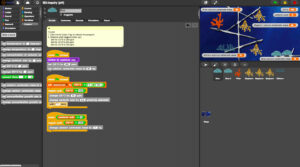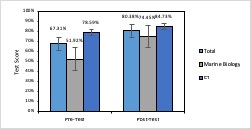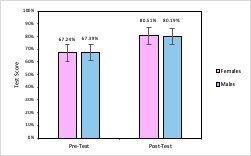The effects of C2STEM on student mastery and motivation in learning marine biology concepts and developing computational thinking skills
ABSTRACT
Computational thinking (CT) has become an increasingly valuable skill as technology and computer science (CS) advance rapidly. The research presented in this paper is guided by the question: Does a learning-by-modeling, computational biology approach support synergistic learning gains in marine biology and CT? This study seeks to understand whether a CT + STEM curriculum is of greater benefit to students than a traditional lecture-based curriculum. In addition to increasing students’ STEM knowledge, they may also learn CT and develop more motivation throughout the curriculum. In this study, 10th grade students interacted with a C2STEM-based curriculum, and their mastery and motivation were measured via multiple tests and surveys. Students were found to experience significant learning gains in CT material and in the accompanying STEM material, which for this study was marine biology with a focus on coral ecology. While the entire class experienced significant gains in motivation and self-efficacy, the female students exclusively showed significant motivation gains. Due to the significant increase in mastery of the course material and in motivation, a CT + STEM structured course may have promising benefits not only in increasing the computational literacy and productivity of future generations, but also in potentially helping to allay the gender disparity within the field of computer science.
INTRODUCTION.
Globalization and technological advancements have placed increasing demands on students and potential employees to develop skills in computational thinking and programming. Employers are searching for applicants with experience in computer science, but currently most precollege students are faced with a lack of exposure to available computer science or computer programming class options. Around 58% of all new jobs in STEM are in computing, but only 22 states have created K-12 computer science education standards [6]. One way to develop these skills in students is to encourage them to program computational models to solve real-world problems. In this study, students are tasked with modeling the environmental changes and threats caused by climate change to corals reefs.
The goal of a CT + Marine Biology C2STEM curriculum is to encourage students to use the logical and critical thinking skills developed from experience with computer programming to solve or illustrate a problem not necessarily related to computer science but well-known to society.
The term computational thinking (CT) is generally defined as a thought process that “involves solving problems, designing systems, and understanding human behavior, by drawing on the concepts fundamental to computer science” [9]. Recently there is also a push to encourage considering CT as a skill that is applicable for all, not just for computer scientists. Other research [2] [3] has taken this idea further, seeking to determine if CT can be taught at a younger age (i.e. middle and high school) and whether the skill amplifies student learning. The research comes at a time when recent job openings increasingly require an aptitude for computer science or computer programming. Thus, due to the increasing relevance and prominence of Science, Technology, Engineering, and Mathematics (STEM)-related fields and careers, education standards currently place STEM courses at the forefront of common core curricula. Among STEM courses, however, researchers and educators continue to disagree over computer science as a discipline, and whether CT can be legitimately separated from computer science and computer programming is still unclear [4].
METHODS.
Designing synergistic marine biology and CT modeling tasks and assessments.
Evidence-Centered Design (ECD) was adopted as a means of supporting the structuring of the curricular content and formative assessments to support student learning. The ECD approach is initiated by a thorough domain analysis of the targeted domains, which are marine biology and CT. Using this approach, disciplinary concepts were unpacked in coordination with a marine biology subject matter expert utilizing the NGSS (NGSS 2013), the K-12 Science Education Framework (NRC 2012), and the K-12 Computer Science Framework (K-12 Computer Science Framework 2016). The unpacking of these concepts was followed by the creation of domain maps to be used in support of the second component of the ECD process—domain modeling.
Domain modeling focuses on designing synergistic learning tasks, starting with developing integrated marine biology and CT learning goals to be addressed in the coral reef curriculum. The relevant domain concepts and practices for marine biology and CT are identified in the domain analysis ECD component. The domain modeling component includes the associated integrated learning goals and the curriculum units for each of the relevant domain analysis components.
The learning-by-modeling approach is operationalized using a block-based, domain specific modeling language (DSML) designed in coordination with our ECD approach. A marine biology DSML was developed in order to facilitate students’ focus on the relevant domain-specific learning objectives, while also providing them the ability to build programs that are concise and self-documenting—thereby helping them understand and interpret the computational constructs needed to build correct marine biology models [7].
The curriculum is designed to simultaneously teach high school students marine biology and computer science by building models of the effects of climate change on coral reefs. The curricular units were (1) Introduction to Coral Reefs, (2) Effects of Temperature on Coral Reefs, (3) Effect of pH Levels on Coral Reefs, and (4) Use of computing and technology to support Coral Reef Research.
The study utilized C2STEM [8], an open-ended learning environment (OELE) that combines block-based, visual programming with DSMLs, discussed above, to promote synergistic STEM+CT learning through computational modeling and problem-solving exercises. The computational modeling component uses NetsBlox, an extension of the Snap! programming language [5].
The first three units of the curriculum were scaffolded into four tasks: inquiry, instructional, embedded assessments, and model building. Inquiry tasks were designed to focus students on developing a conceptual understanding of domain processes (e.g. the effect of increasing ocean temperature on coral species). Instructional tasks allowed students to develop simple models using the learned science knowledge and CT concepts and practices, while model building tasks extended this application through more advanced CT constructs.
For instance, in an instructional task, students may be given a program in which the ocean temperature fluctuates (similar to the annual changes in ocean temperatures experienced by coral reefs), and they are guided to program (i.e. build a model) of the resulting behavior of a specific coral species for certain temperature ranges (as temperature increases, the coral expels the symbiotic algae that live in their tissues). This helps them develop an understanding of a specific process (effects of temperature) that impacts the symbiotic relationship between the coral and algae. For a model building task, students are asked to construct computational models that describe the effects of temperature change (temperature is modeled as a global variable) on four different coral species, considering the conditional behavior changes for each type of coral. Parameter values for these models are derived from real-world data acquired from domain experts.
Finally, formative, embedded assessments, designed using the ECD process, were integrated into our curriculum for monitoring and assessing student learning gains through the study. Figure 1 illustrates an example inquiry task for our unit on pH and coral reefs.
Figure 1. An inquiry task is shown above. An inquiry task is designed to generate interest in the programming environment, and to facilitate student’s exposure to their initially unfamiliar working environment.
Empirical study using integrated marine biology and CT assessments.
Twenty-five high school sophomores participated in an 8-day, 12-hour study. Students worked on all tasks individually. Instruction, including lectures and video (selected during the ECD process with the help of a marine biology expert), were given as introductions to each unit topic. A pre-test was administered prior to Module 1 and the accompanying post-test was administered following the completion of Module 4.
The research presented in this paper is guided by the question: Does a learning-by-modeling, computational biology approach support synergistic learning gains in marine biology and CT? The primary data source used to answer this question are the pre- and post-tests. The pre- and post-tests were designed using the ECD approach and assessed student knowledge of relevant marine biology and CT constructs.
Surveying Motivation.
Students were given surveys at the beginning and end of the study period. Survey questions were collated into categories: (1) Task Value, (2) Tech Attitudes, (3) Self-Efficacy, and (4) Dissemination Potential. Task Value questions are based on the expectancy-value theory and reflect the student’s evaluation of the subjective importance of the subject material. Tech Attitudes questions are task value questions specific to students’ evaluation of the use of technology in education. Self-Efficacy questions measure a student’s self-rated confidence in his or her own innate ability to achieve goals [1]. Dissemination Potential questions asked the student to evaluate the likelihood he or she would share the material that he or she learned to others. This gauges education as a means of spreading awareness. The central topic of this curriculum is the identification of a current environmental problem and its causes, whose solution would require others being correctly informed and made aware of the issue.
RESULTS.
The class averages for the pre-test and post-test scores are shown in Figure 2. Overall, the entire class demonstrated an increased mastery of CT skills and marine biology concepts. Initially, the class average was 61.73% total test questions correct, later rising 80.38% questions correct (p value < 0.0001, using a t-test: paired two sample for means). The class average scores represent a comprehensive overview of all the students’ test scores, encompassing both the marine biology content and the CT content. When observing each discipline individually, it was shown that the students experienced significant learning gains of mastery in both areas. In marine biology, students’ test scores reported a p value < 0.0001, using a t-test: paired two sample for means. In CT, students’ test scores also reported a p value = 0.0008 using a t-test: paired two sample for means.
Figure 2. The class averages for the pre-test and post-test scores are shown above. The dark blue bars represent the class averages for the comprehensive test scores. The gray bars represent the class averages specifically for the marine biology test material. The light blue bars represent the class averages specifically for the computer programming and computational thinking test material. Standard deviations also shown.
A primary focus of surveying motivation was to gauge the students’ changes in self-efficacy. The class averages, by gender, for the self-efficacy component of the motivation test scores is shown in Figure 3. Initially, the female students were observed to have significantly lower self-efficacy scores than their male classmates (p value = 0.0115, using a t-test: two sample assuming unequal variances). The results of the final motivation survey, however, show that the females’ self-efficacy is no longer significantly lower than the males’ (p value = 0.2871, using a t-test: two sample assuming unequal variance). It should also be noted that the female students, on average, experienced a significant increase in self-efficacy over the course of the study (p value = 0.0010, using a t-test: paired two sample for means). Yet, their male classmates did not demonstrate significant growth (p value = 0.0891, using a t-test: paired two sample for means).
Figure 3. The class averages, organized by gender, in the self-efficacy component of the motivation survey are shown above. While both groups demonstrated observable gains, only the females’ increase in self-efficacy was significant. Standard deviations also shown.
DISCUSSION.
This paper outlines the design, implementation, and preliminary evaluation of a learning-by- modeling curriculum focused on the synergistic learning of marine biology and CT. The results indicate that an ECD approach is beneficial to designing learning-by-modeling environments that explicitly include key domain concepts and practices in their curriculum. Therefore, a CT-based approach to teaching a STEM discipline can be effective and productive for student learning.
The extent of the global endangerment of coral species has intensified research and the availability of data to support understanding of the impact of climate change on coral reefs. The U.S. education system has come to represent an overarching concept regarding the dissemination of knowledge. A key component of this purpose is the dissemination of knowledge via spreading awareness to a particular and dire problem, such as climate change. C2STEM provides an accessible and user-friendly platform to spread information and awareness about a topic like climate change. Through the learning-by-modeling curriculum design, students are given several visual aids that help illustrate a phenomenon they might otherwise not be able to see. Students are encouraged to realize that even if they do not feel directly affected by crises such as climate change, this does not necessarily mean that the problem is any less urgent.
The results of the pre-/post-test questions indicate significant synergistic learning benefits were gained in the learning-by-modeling approach of this project. Debugging, an important practice in computing, directly maps on to model testing and refinement, a fundamental component of the NGSS framework.
When comparing a C2STEM-scaffolded education to a lecture-based approach, the results showed that there was no significant difference between the learning gains (i.e. the post-test scores) of students who used C2STEM and students who did not in their mastery of the supplemental STEM discipline [11]. However, there was a significant difference between the two groups in their mastery of CT concepts. This could imply that a CT-based approach provides more for students’ learning, as they receive the same amount of content from those who partake only in a lecture-based class, but they also receive the additional benefit of honing their CT abilities and developing fundamental computer programming skills. The results of this study reaffirmed this, as the students were shown to have increased significantly in their mastery of CT and of marine biology via the learning-by-modeling framework of C2STEM.
An interesting observation was the significant increase in female students’ motivation after their experience with the C2STEM curriculum, but the lack thereof for the male students. Initially, male students were significantly more motivated, but afterwards, due to the significant increase in female students’ motivation, there was no significant difference between male and female motivation. When the students’ self-efficacy scores were isolated from the rest of their motivation scores, the trend was observed again. Female students experienced a significant growth in self-efficacy, whereas the male students did not. Additionally, the initial self-efficacy of the male students was significantly higher than the female students’, but by the end of the study, there was no significant difference between the two groups’ self-efficacies, due to the female students’ growth. In past and similar studies of student motivation and C2STEM, this trend has not been observed [8], so it is incumbent that future work attempts to isolate possible reasons why this particular study observed these patterns. Separating student responses by gender can help identify underlying causes for the gender gap in computer science. While nearly as many women hold undergraduate degrees as men overall, they make up only about 30% of all STEM degree holders [10]. A key intention of C2STEM is to turn computer science and computer programming into more accessible and more common course options for precollege students. This includes striving to remove gender-based stereotypes associated with computer science, so that the discipline may truly appear more approachable.
Further possible future directions include expanding the marine biology curriculum, now that the functionality of the new marine biology DSML blocks has been confirmed. A more diverse curriculum would be needed in order to compare C2STEM-enhanced education with traditional curricula.
ACKNOWLEDGMENTS.
We would like to express our gratitude for the School for Science and Math at Vanderbilt and the Institute for Software Integrated Systems for hosting this research project. We especially would like to thank Dr. Jordan Grigor for his contributions. This material is based in part upon work supported by the National Science Foundation under NSF Award DRL-1640199.
REFERENCES
[1] A. Bandura, Self-efficacy mechanism in human agency. American Psychologist 37, 122-147 (1982).
[2] S. Basu, K. W. McElhaney, S. Grover, C. J. Harris, G. Biswas, “A principled approach to designing assessments that integrate science and computational thinking,” presented at the 13th International Conference of the Learning Sciences, London, England, 2018.
[3] S. Basu, G. Biswas, J. S. Kinnebrew, Learner modeling for adaptive scaffolding in a Computational Thinking-based science learning environment, User Modeling and User-Adapted Interaction 27, 5-53 (2017).
[4] S. Basu, G. Biswas, J. S. Kinnebrew, Using Multiple Representations to simultaneously learn Computational Thinking and Middle School Science,” presented at the 30th AAAI Conference on Artificial Intelligence, Phoenix, Arizona, 2016.
[5] B. Broll, P. Völgesi, J. Sallai, A. Lédeczi, Netsblox: a visual language and web-based environment for teaching distributed programming, (2016).
[6] code.org, https://code.org/promote/ca (2019).
[7] A. van Deursen, P. Klint, J. Visser, Domain-Specific Languages: an annotated bibliography, ACM SIGPLAN Notices 35, 26-36 (2000).
[8] N. Hutchins, G. Biswas, M. Maroti, B. Broll, A. Ledezci, “C2STEM: a design-based approach to a classroom-centered OELE,” presented at the 19th International Conference on Artificial Intelligence in Education, London, England, June 2018.
[9] S. Papert, in Mindstorms: Children, computers, and powerful ideas (Basic Books, New York, ed. 2, 1993).
[10] U.S. Department of Commerce: Economics & Statistics Administration, http://www.esa.doc.gov/reports/women-stem-2017-update (2017).
[11] N. Hutchins, N. Zhang, G. Biswas, “The Confidence Drop: The Need to Actively Address Computational Thinking Confidence in Middle School,” presented at the Special Interest Group on Computer Science Education (SIGCSE) Technical Symposium, Seattle, Washington, U.S.A., 2017.
Posted by John Lee on Tuesday, December 22, 2020 in May 2019.
Tags: Computational thinking, K-12 education, learning by modeling, marine biology education, synergistic learning



